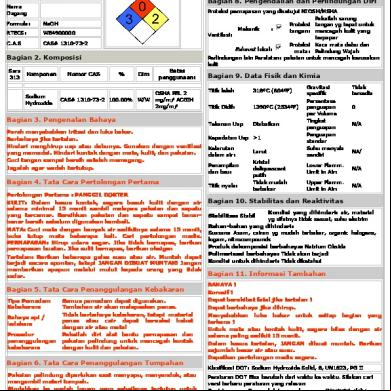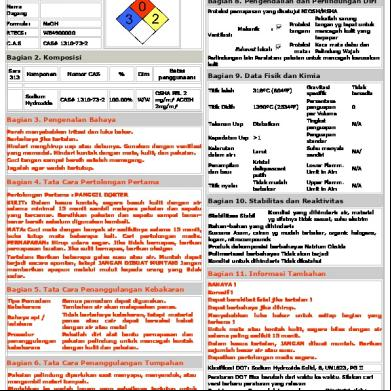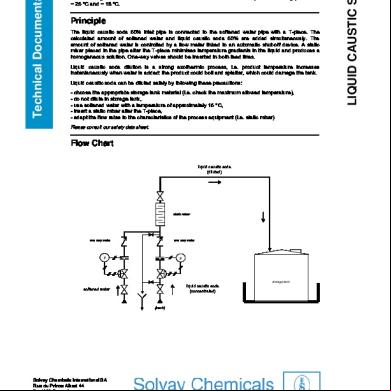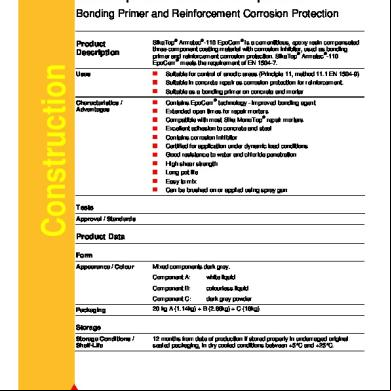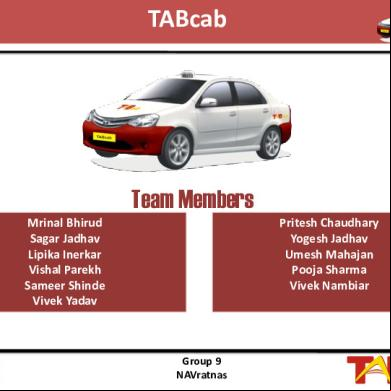Caustic Soda Flakes Msds 2v335s
This document was ed by and they confirmed that they have the permission to share it. If you are author or own the copyright of this book, please report to us by using this report form. Report 2z6p3t
Overview 5o1f4z
& View Caustic Soda Flakes Msds as PDF for free.
More details 6z3438
- Words: 1,269
- Pages: 3
CAUSTIC SODA FLAKES:
Point No.1
Chemical Product & Company Identification Chemical product – Sodium Hydroxide flakes/prills (CAUSTIC SODA FLAKES / PRILLS) M/s. Gujarat Alkalies & Chemicals Limited. P.O. Petrochemicals, Dist. Vadodara Pin code no. 391 346 State – Gujarat, INDIA Telephone No. 2232681, 2232981 –82, 2232039 Fax No. 91 265 2232130 / 2230026
Point No. 2
Composition & information on ingredients NaOH, Sodium hydroxide Flakes/ Prills
Point No. 3
Hazards Identification Emergency Overview POISON! DANGER! CORROSIVE. MAY BE FATAL IF SWALLOWED. HARMFUL IF INHALED. CAUSES BURNS TO ANY AREA OF . REACTS WITH WATER, ACIDS AND OTHER MATERIALS. Potential Health Effects Inhalation: Severe irritant. Effects from inhalation of dust or mist vary from mild irritation to serious damage of the upper respiratory tract, depending on severity of exposure. Symptoms may include sneezing, sore throat or runny nose. Severe pneumonitis may occur. Ingestion: Corrosive! Swallowing may cause severe burns of mouth, throat, and stomach. Severe scarring of tissue and death may result. Symptoms may include bleeding, vomiting, diarrhea, fall in blood pressure. Damage may appears days after exposure. Skin : Corrosive! with skin can cause irritation or severe burns and scarring with greater exposures. Eye : Corrosive! Causes irritation of eyes, and with greater exposures it can cause burns that may result in permanent impairment of vision, even blindness. Chronic Exposure: Prolonged with dilute solutions or dust has a destructive effect upon tissue. Aggravation of Pre-existing Conditions: Persons with pre-existing skin disorders or eye problems or impaired respiratory function may be more susceptible to the effects of the substance.
Point No. 4
First Aid Measures Inhalation: Remove to fresh air. If not breathing, give artificial respiration. If breathing is difficult, give oxygen. Call a physician. Ingestion: DO NOT INDUCE VOMITING! Give large quantities of water or milk if available. Never give anything by mouth to an unconscious person. Get medical attention immediately. Skin : Immediately flush skin with plenty of water for at least 15 minutes while removing contaminated clothing and shoes. Call a physician, immediately. Wash clothing before reuse. Eye : Immediately flush eyes with plenty of water for at least 15 minutes, lifting lower and upper eyelids occasionally. Get medical attention immediately.
Point No. 5
Fire Fighting Measures Fire: Not considered to be a fire hazard. Hot or molten material can react violently with water. Can react with certain metals, such as aluminum, to generate flammable hydrogen gas. Explosion: Not considered to be an explosion hazard. Fire Extinguishing Media: Use any means suitable for extinguishing surrounding fire. Adding water to caustic solution generates large amounts of heat.
Point No. 6
Accidental Release Measures Ventilate area of leak or spill. Keep unnecessary and unprotected people away from area of spill. Wear appropriate personal protective equipment as specified in Section 8. Spills: Pick up and place in a suitable container for reclamation or disposal, using a method that does not generate dust. Do not flush caustic residues to the sewer. Residues from spills can be diluted with water, neutralized with dilute acid such as acetic, hydrochloric or sulfuric. Absorb neutralized caustic residue on clay, vermiculite or other inert substance and package in a suitable container for disposal.
Point no. 7
Handling and Storage Keep in a tightly closed container. Protect from physical damage. Store in a cool, dry, ventilated area away from sources of heat, moisture and incompatibilities. Always add the caustic to water while stirring; never the reverse. Containers of this material may be hazardous when empty since they retain product residues (dust, solids); observe all warnings and precautions listed for the product. Do not store with aluminum or magnesium. Do not mix with acids or organic materials.
Point no. 8
Exposure Controls/Personal Protection Airborne Exposure Limits: OSHA Permissible Exposure Limit (PEL): 2 mg/m3 Ceiling - ACGIH Threshold Limit Value (TLV): 2 mg/m3 Ceiling Ventilation System: A system of local and/or general exhaust is recommended to keep employee exposures below the Airborne Exposure Limits. Local exhaust ventilation is generally preferred because it can control the emissions of the contaminant at its source, preventing dispersion of it into the general work area. Please refer to the ACGIH document, Industrial Ventilation, A Manual of Recommended Practices, most recent edition, for details. Personal Respirators : If the exposure limit is exceeded, a half-face dust/mist respirator may be worn for up to ten times the exposure limit or the maximum use concentration specified by the appropriate regulatory agency or respirator supplier, whichever is lowest. A full-face piece dust/mist respirator may be worn up to 50 times the exposure limit, or the maximum use concentration specified by the appropriate regulatory agency, or respirator supplier, whichever is lowest. For emergencies or instances where the exposure levels are not known, use a full-face piece positive-pressure, air-supplied respirator. WARNING: Air-purifying respirators do not protect workers in oxygen-deficient atmospheres. Skin Protection: Wear impervious protective clothing, including boots, gloves, lab coat, apron or coveralls, as appropriate, to prevent skin . Eye Protection: Use chemical safety goggles and/or a full face shield where splashing is possible. Maintain eye wash fountain and quick-drench facilities in work area.
Point No. 9
Physical and Chemical Properties Appearance: White, deliquescent pellets. Odor: Odorless. Solubility: 111 g/100 g of water. Specific Gravity: 2.13 pH: 13 - 14 (0.5% soln.) % Volatiles by volume @ 21C (70F): 0 Boiling Point: 1390C (2534F) Melting Point: 318C (604F) Vapor Density (Air=1): > 1.0 Vapor Pressure (mm Hg): Negligible. Evaporation Rate (BuAc=1): No information found.
Point No. 10
Stability and Reactivity Stability: Stable under ordinary conditions of use and storage. Very hygroscopic. Can slowly pick up moisture from air and react with carbon dioxide from air to form sodium carbonate. Hazardous Decomposition Products: Sodium Hydroxide. Decomposition by reaction with certain metals releases flammable and explosive hydrogen gas. Hazardous Polymerization: Will not occur. Incompatibilities: with water, acids, flammable liquids, and organic halogen compounds, especially trichloroethylene, may cause fire or explosion. with nitromethane and other similar nitro compounds causes formation of shock-sensitive salts. with metals such as aluminum, tin, and zinc causes formation of flammable hydrogen gas. Conditions to Avoid: Moisture, dusting and incompatibles.
Point No. 11
Toxicological Information Irritation data: skin, rabbit: 500 mg/24H severe; eye rabbit: 50 ug/24H severe; investigated as a mutagen.
Point No. 12
Ecological Information Environmental Fate: No information found. Environmental Toxicity: No information found.
Point No. 13
Disposal Considerations Whatever cannot be saved for recovery or recycling should be handled as hazardous waste and sent to a RCRA approved waste facility. Processing, use or contamination of this product may change the waste management options. State and local disposal regulations may differ from federal disposal regulations. Dispose of container and unused contents in accordance with federal, state and local requirements.
Point No. 14
Transport Information Domestic (Land, D.O.T.) ----------------------Proper Shipping Name: SODIUM HYDROXIDE, SOLID Hazard Class: 8 UN/NA: UN1823 Packing Group: II CAS No. 1310-73-2
Point No. 15
Regulatory Information --------------------------EEC labeling – Sodium Hydroxide Symbol – C - Corrosive, Phruses- R 35 – Causes server burns.
Point No. 16
Other Information NFPA Ratings: Health: 3 Flammability: 0 Reactivity: 1 Information contained in this material data sheet is believed to be reliable but no representation, guarantee or warranties of any kind are made as to its accuracy, suitability for a particular application or results to be obtained from them. It is upto the manufacturer/seller to ensure that the information contained in the material safety data sheet is relevant to the product manufactured/handled or sold by him as the case may be. The Government makes no warranties, expressed or implied, in respect of the adequacy of this document for any particular purpose.
Point No.1
Chemical Product & Company Identification Chemical product – Sodium Hydroxide flakes/prills (CAUSTIC SODA FLAKES / PRILLS) M/s. Gujarat Alkalies & Chemicals Limited. P.O. Petrochemicals, Dist. Vadodara Pin code no. 391 346 State – Gujarat, INDIA Telephone No. 2232681, 2232981 –82, 2232039 Fax No. 91 265 2232130 / 2230026
Point No. 2
Composition & information on ingredients NaOH, Sodium hydroxide Flakes/ Prills
Point No. 3
Hazards Identification Emergency Overview POISON! DANGER! CORROSIVE. MAY BE FATAL IF SWALLOWED. HARMFUL IF INHALED. CAUSES BURNS TO ANY AREA OF . REACTS WITH WATER, ACIDS AND OTHER MATERIALS. Potential Health Effects Inhalation: Severe irritant. Effects from inhalation of dust or mist vary from mild irritation to serious damage of the upper respiratory tract, depending on severity of exposure. Symptoms may include sneezing, sore throat or runny nose. Severe pneumonitis may occur. Ingestion: Corrosive! Swallowing may cause severe burns of mouth, throat, and stomach. Severe scarring of tissue and death may result. Symptoms may include bleeding, vomiting, diarrhea, fall in blood pressure. Damage may appears days after exposure. Skin : Corrosive! with skin can cause irritation or severe burns and scarring with greater exposures. Eye : Corrosive! Causes irritation of eyes, and with greater exposures it can cause burns that may result in permanent impairment of vision, even blindness. Chronic Exposure: Prolonged with dilute solutions or dust has a destructive effect upon tissue. Aggravation of Pre-existing Conditions: Persons with pre-existing skin disorders or eye problems or impaired respiratory function may be more susceptible to the effects of the substance.
Point No. 4
First Aid Measures Inhalation: Remove to fresh air. If not breathing, give artificial respiration. If breathing is difficult, give oxygen. Call a physician. Ingestion: DO NOT INDUCE VOMITING! Give large quantities of water or milk if available. Never give anything by mouth to an unconscious person. Get medical attention immediately. Skin : Immediately flush skin with plenty of water for at least 15 minutes while removing contaminated clothing and shoes. Call a physician, immediately. Wash clothing before reuse. Eye : Immediately flush eyes with plenty of water for at least 15 minutes, lifting lower and upper eyelids occasionally. Get medical attention immediately.
Point No. 5
Fire Fighting Measures Fire: Not considered to be a fire hazard. Hot or molten material can react violently with water. Can react with certain metals, such as aluminum, to generate flammable hydrogen gas. Explosion: Not considered to be an explosion hazard. Fire Extinguishing Media: Use any means suitable for extinguishing surrounding fire. Adding water to caustic solution generates large amounts of heat.
Point No. 6
Accidental Release Measures Ventilate area of leak or spill. Keep unnecessary and unprotected people away from area of spill. Wear appropriate personal protective equipment as specified in Section 8. Spills: Pick up and place in a suitable container for reclamation or disposal, using a method that does not generate dust. Do not flush caustic residues to the sewer. Residues from spills can be diluted with water, neutralized with dilute acid such as acetic, hydrochloric or sulfuric. Absorb neutralized caustic residue on clay, vermiculite or other inert substance and package in a suitable container for disposal.
Point no. 7
Handling and Storage Keep in a tightly closed container. Protect from physical damage. Store in a cool, dry, ventilated area away from sources of heat, moisture and incompatibilities. Always add the caustic to water while stirring; never the reverse. Containers of this material may be hazardous when empty since they retain product residues (dust, solids); observe all warnings and precautions listed for the product. Do not store with aluminum or magnesium. Do not mix with acids or organic materials.
Point no. 8
Exposure Controls/Personal Protection Airborne Exposure Limits: OSHA Permissible Exposure Limit (PEL): 2 mg/m3 Ceiling - ACGIH Threshold Limit Value (TLV): 2 mg/m3 Ceiling Ventilation System: A system of local and/or general exhaust is recommended to keep employee exposures below the Airborne Exposure Limits. Local exhaust ventilation is generally preferred because it can control the emissions of the contaminant at its source, preventing dispersion of it into the general work area. Please refer to the ACGIH document, Industrial Ventilation, A Manual of Recommended Practices, most recent edition, for details. Personal Respirators : If the exposure limit is exceeded, a half-face dust/mist respirator may be worn for up to ten times the exposure limit or the maximum use concentration specified by the appropriate regulatory agency or respirator supplier, whichever is lowest. A full-face piece dust/mist respirator may be worn up to 50 times the exposure limit, or the maximum use concentration specified by the appropriate regulatory agency, or respirator supplier, whichever is lowest. For emergencies or instances where the exposure levels are not known, use a full-face piece positive-pressure, air-supplied respirator. WARNING: Air-purifying respirators do not protect workers in oxygen-deficient atmospheres. Skin Protection: Wear impervious protective clothing, including boots, gloves, lab coat, apron or coveralls, as appropriate, to prevent skin . Eye Protection: Use chemical safety goggles and/or a full face shield where splashing is possible. Maintain eye wash fountain and quick-drench facilities in work area.
Point No. 9
Physical and Chemical Properties Appearance: White, deliquescent pellets. Odor: Odorless. Solubility: 111 g/100 g of water. Specific Gravity: 2.13 pH: 13 - 14 (0.5% soln.) % Volatiles by volume @ 21C (70F): 0 Boiling Point: 1390C (2534F) Melting Point: 318C (604F) Vapor Density (Air=1): > 1.0 Vapor Pressure (mm Hg): Negligible. Evaporation Rate (BuAc=1): No information found.
Point No. 10
Stability and Reactivity Stability: Stable under ordinary conditions of use and storage. Very hygroscopic. Can slowly pick up moisture from air and react with carbon dioxide from air to form sodium carbonate. Hazardous Decomposition Products: Sodium Hydroxide. Decomposition by reaction with certain metals releases flammable and explosive hydrogen gas. Hazardous Polymerization: Will not occur. Incompatibilities: with water, acids, flammable liquids, and organic halogen compounds, especially trichloroethylene, may cause fire or explosion. with nitromethane and other similar nitro compounds causes formation of shock-sensitive salts. with metals such as aluminum, tin, and zinc causes formation of flammable hydrogen gas. Conditions to Avoid: Moisture, dusting and incompatibles.
Point No. 11
Toxicological Information Irritation data: skin, rabbit: 500 mg/24H severe; eye rabbit: 50 ug/24H severe; investigated as a mutagen.
Point No. 12
Ecological Information Environmental Fate: No information found. Environmental Toxicity: No information found.
Point No. 13
Disposal Considerations Whatever cannot be saved for recovery or recycling should be handled as hazardous waste and sent to a RCRA approved waste facility. Processing, use or contamination of this product may change the waste management options. State and local disposal regulations may differ from federal disposal regulations. Dispose of container and unused contents in accordance with federal, state and local requirements.
Point No. 14
Transport Information Domestic (Land, D.O.T.) ----------------------Proper Shipping Name: SODIUM HYDROXIDE, SOLID Hazard Class: 8 UN/NA: UN1823 Packing Group: II CAS No. 1310-73-2
Point No. 15
Regulatory Information --------------------------EEC labeling – Sodium Hydroxide Symbol – C - Corrosive, Phruses- R 35 – Causes server burns.
Point No. 16
Other Information NFPA Ratings: Health: 3 Flammability: 0 Reactivity: 1 Information contained in this material data sheet is believed to be reliable but no representation, guarantee or warranties of any kind are made as to its accuracy, suitability for a particular application or results to be obtained from them. It is upto the manufacturer/seller to ensure that the information contained in the material safety data sheet is relevant to the product manufactured/handled or sold by him as the case may be. The Government makes no warranties, expressed or implied, in respect of the adequacy of this document for any particular purpose.


